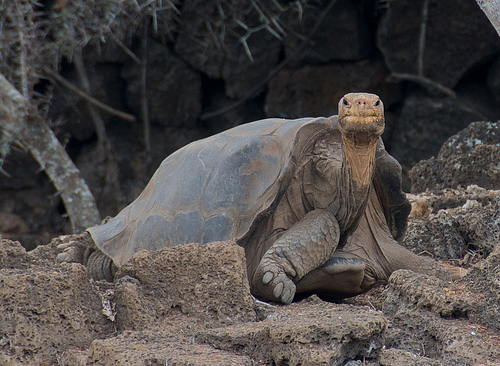
Lonesome George wants you to get off his lawn. (Photo by A. Davey.)
Lonesome George, the last of the tortoise subspecies Chelonoidis nigra abingdoni from Pinta island in the Galapagos, has died at age 100. Previously known as the world’s rarest tortoise, old George is survived by his girlfriends Becki and Becki (I assume) of subspecies C. nigra becki — conservationists tried breeding George with similar tortoises in hopes of perpetuating the Pinta genes, but even when mating was successful, the eggs all failed to hatch. Still, if you have to go, this isn’t a bad way to do it: famous, old, and surrounded by exotic women.
Actually, George wasn’t even that old as giant tortoises go — he was at best middle-aged, since Galapagos tortoises can live up to 200 years. But he’s seen a lot, from the feral goats that decimated Pinta Island’s vegetation and killed off his kin, to the conservation efforts that eradicated the goats and made Pinta green again. Since the early 1970s, when he was discovered alone on the island, George has been a symbol of the Galapagos — in fact, Galapagos National Park officials say that his body will probably be preserved in a sort of Lenin’s Tomb arrangement, so that visitors can still see the iconic tortoise in most of his glory.
If you have a soft heart for animals, or if you’re a history-of-science nerd (the various Galapagos tortoise subspecies were, I probably don’t need to remind you, critical for Charles Darwin’s discovery of the principles of natural selection), you’re probably a little broken up about this. So here’s a video of a baby box turtle — which, okay, is a different genus and species, but it’s the same order, and the same form factor! — eating a raspberry with dangerous adorableness.




